 | Trend
| Seasonally adjusted
|  |
 | Quarterly % change Sep 04 to Dec 04 | Annual % change Dec 03 to Dec 04 | % points contribution to growth in DFD Sep 04 to Dec 04 | Quarterly % change Sep 04 to Dec 04 | Annual % change Dec 03 to Dec 04 | % points contribution to growth in DFD Sep 04 to Dec 04 |  |
|  |
| New South Wales | 0.6 | 2.8 | 0.2 | 1.2 | 3.1 | 0.4 |  |
| Victoria | 0.9 | 4.2 | 0.2 | 1.7 | 4.9 | 0.4 |  |
| Queensland | 1.5 | 7.2 | 0.3 | -0.6 | 4.1 | -0.1 |  |
| South Australia | 0.7 | 3.6 | - | 1.2 | 4.2 | 0.1 |  |
| Western Australia | 1.1 | 5.5 | 0.1 | 0.8 | 4.8 | 0.1 |  |
| Tasmania | 1.2 | 5.5 | - | 3.2 | 6.1 | 0.1 |  |
| Northern Territory | -0.2 | -1.3 | - | 1.8 | -0.9 | - |  |
| Australian Capital Territory | 1.0 | 3.9 | - | 0.1 | 3.1 | - |  |
| Australia (DFD)(a) | 1.0 | 4.5 | 1.0 | 1.0 | 4.0 | 1.0 |  |
|  |
| - nil or rounded to zero (including null cells) |
| (a) Domestic final demand. |
DECEMBER QUARTER
Summary Comments
State Final Demand
- In trend terms growth in the December quarter was strongest in Queensland (up 1.5%) and Tasmania (up 1.2%) and weakest in the Northern Territory (down 0.2%). In seasonally adjusted terms, Tasmania (up 3.2%) showed the strongest growth with the major contributor being public gross fixed capital formation. Seasonally adjusted growth was weakest in Queensland (down 0.6%) due mainly to a decline in household final consumption expenditure.
Household final consumption expenditure
- Trend growth in the December quarter ranged from 0.5% in South Australia to 1.5% in the Northern Territory. Growth in seasonally adjusted terms was recorded in all states except Queensland (down 0.7%).
Government final consumption expenditure
- In trend terms, all states experienced growth in government final consumption expenditure. Seasonally adjusted growth was strongest in Tasmania (up 4.0%), New South Wales (up 2.9%) and Victoria (up 2.8%). Queensland (down 0.6%) and the Northern Territory (down 0.3%) fell in seasonally adjusted terms.
Private gross fixed capital formation
- The pattern of growth in trend terms varied across the states, with Queensland showing the strongest growth at 2.2%. Seasonally adjusted growth was strongest in Victoria (up 4.7%) and the Northern Territory (up 3.4%) while the Australian Capital Territory had the largest fall (down 5.5%).
- Investment in machinery and equipment rose strongly across all states (seasonally adjusted) except in Queensland, which fell by -2.2%. Non dwelling construction investment (seasonally adjusted) rose strongly in New South Wales (up 16.3%) with large falls in Tasmania (down 28.5%) and the Australian Capital Territory (down 29.3%). Dwelling investment (seasonally adjusted) fell in the Australian Capital Territory (down 15.9%) and in New South Wales (down 10.8%). The strongest rises were in the Northern Territory (up 4.6%) and Victoria (up 2.8%).
Public gross fixed capital formation
- The pattern of growth in trend terms varied across the states. In seasonally adjusted terms, the strongest growth occurred in Tasmania (up 63.3%), while Western Australia had the largest fall (down 8.5%).
ANALYSIS AND COMMENTS
GROWTH RATES IN GDP
The graph below provides a comparison of the quarterly growth rates for chain volume measures of GDP in both seasonally adjusted and trend terms over the last fourteen years. Following the fall in GDP (in seasonally adjusted chain volume terms) in December quarter 2000 there have been 16 consecutive quarters of growth.
Percentage Changes, Chain volume measures

Growth (in trend chain volume terms) over the past four quarters has been driven by public gross fixed capital formation (up 10.9%), private business investment (up 9.7%) and household final consumption expenditure (up 4.3%). Offsetting these strong contributions was the strong rise in imports of goods and services (up 11.3%). On the industry side, the strongest contributors over the past four quarters have been cultural and recreational services (up 7.5%) and health and community services (up 6.5%). Detracting from growth were falls in agriculture, forestry and fishing (down 8.4%), accommodation, cafes and restaurants (down 2.9%) and manufacturing (down 1.1%) over the period.
REAL GROSS DOMESTIC INCOME
A measure of the real purchasing power of income generated by domestic production is the chain volume measure of GDP adjusted for the terms of trade effect, which is referred to as real gross domestic income (see Glossary for definition). The graph below provides a comparison of quarterly movements in trend GDP (chain volume measure) and real gross domestic income. During the December quarter, trend real gross domestic income increased by 0.6%, compared to the increase in the trend chain volume measure of GDP of 0.3%, reflecting an improvement in the terms of trade. Trend and seasonally adjusted estimates of real gross domestic income are shown in tables 1 and 2.
PERCENTAGE CHANGES, Trend
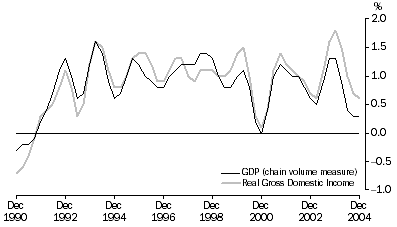
The graph below shows the trend terms of trade over the past fourteen years. The strong rise in the terms of trade since 1999 reflects strong growth in export prices relative to import prices and implies an increase in purchasing power for Australia relative to its trading partners.
An article that discusses the terms of trade and the national accounts has been released on the ABS web site <https://www.abs.gov.au> concurrently with the release of this publication.
Trend, (2002-03 = 100)
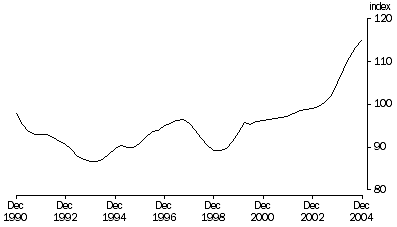
REAL NET NATIONAL DISPOSABLE INCOME
A broader measure of change in national economic wellbeing is real net national disposable income. This measure adjusts the chain volume measure of GDP for the terms of trade effect, real net incomes from overseas and consumption of fixed capital (see Glossary for definition). The graph below provides a comparison of quarterly movements in trend GDP (chain volume measure) and real net national disposable income. During the December quarter, trend real net national disposable income increased by 0.1%, while the increase in the trend chain volume measure of GDP was 0.3%.
Percentage Changes, Trend
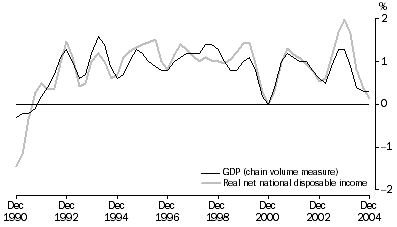
HOUSEHOLD SAVING RATIO
In both trend and seasonally adjusted terms the household saving ratio (see Glossary for definition) was negative in the December quarter 2004, implying that household consumption was greater than household disposable income. In trend terms the ratio was -2.2% in the December quarter 2004 and in seasonally adjusted terms it was -2.3%. The following graph presents the household saving ratio derived from trend and seasonally adjusted data.
Household saving ratio, Current prices
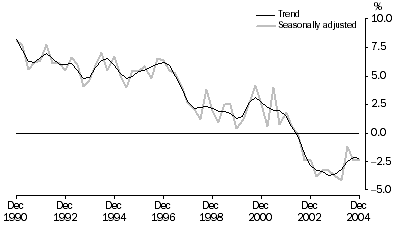
Although seasonally adjusted household saving has been negative over the past two years, net national saving has been positive over the same period. The net national saving ratio in the December quarter 2004 was 3.3% in seasonally adjusted terms.
Caution should be exercised in interpreting the household saving ratio in recent years, because major components of household income and expenditure may still be subject to significant revisions. The impact of these revisions on the saving ratio can cause changes in the apparent direction of the trend.
COMPENSATION OF EMPLOYEES
In December quarter 2004, seasonally adjusted compensation of employees grew by 1.8%, while the seasonally adjusted number of employees recorded in the Labour Force survey grew by 1.1%. Thus, average compensation per employee increased by 0.7%. This follows growth of 0.8% and 0.5% in the previous two quarters. The growth rate over the twelve months to December quarter 2004 was 3.7% in seasonally adjusted terms compared with 3.6% growth over the same period in the total hourly rates of pay, excluding bonuses as published in Labour Price Index, Australia (cat. no. 6345.0). (It should be noted that the conceptual bases for the two wage measures are different.)
PRIVATE NON-FARM INVENTORIES TO TOTAL SALES RATIO
In trend current price terms, the book value of private non-farm inventories increased by $1,948 million (1.9%) in the December quarter 2004, while total sales rose by $2,561 million (2.0%). Consequently, the trend inventories to total sales ratio (see Glossary for definition) was 0.793 in both the September and December quarters 2004. The following graph presents the ratio of private non-farm inventories to total sales over the last fourteen years.
Trend, Current Prices
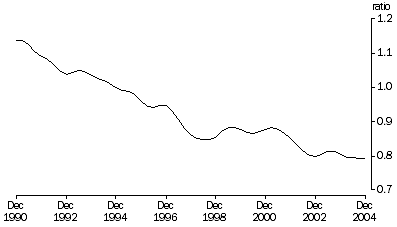
IMPORTS TO DOMESTIC SALES
The imports to domestic sales ratio (see Glossary for definition), trended and at current prices, rose from 0.359 in the September quarter 2004 to 0.361 in the December quarter 2004. This reflects a rise of 2.5% in imports of goods accompanied by a 1.7% rise in domestic sales. The following graph presents the ratio of imports to domestic sales over the last fourteen years.
Trend, Current Prices

RELIABILITY OF CONTEMPORARY TREND ESTIMATES
Trend estimates are used throughout this publication as an alternative approach to the analysis of movements in time series data. Further details regarding the procedures used to estimate the trend series are described in the Explanatory Notes (paragraphs 13 - 17) and in Information Paper: A Guide to Interpreting Time Series - Monitoring Trends, 2003 (cat. no. 1349.0) released in August 2003.
Potential revisions to trend estimates can be indicated by showing the effects of particular changes in seasonally adjusted estimates that might occur in the next quarter. The table below shows the trend estimates for the last ten quarters and the values to which they would be revised if the given movements in seasonally adjusted GDP actually occurred in March quarter 2005. Seasonally adjusted growth of 0.5% is required in March quarter 2005 to maintain, in March quarter 2005, the trend growth of 0.3% currently estimated for the December quarter 2004.
Percentage change in GDP Chain volume measure |
|  |
 |  |  |  | Trend estimate if seasonally adjusted GDP changes by the following amounts in March qtr 2005
|  |
 |  | Seasonally adjusted GDP as published in table 2 | Trend GDP as published in table 1 | Grows by 1.0% | No change | Falls by 1.0% |  |
|  |
| 2002 |  |  |  |  |  |  |
 | September | 0.7 | 0.8 | 0.8 | 0.8 | 0.8 |  |
 | December | 0.5 | 0.6 | 0.6 | 0.6 | 0.6 |  |
| 2003 |  |  |  |  |  |  |
 | March | 0.7 | 0.5 | 0.5 | 0.5 | 0.5 |  |
 | June | 0.4 | 0.9 | 0.9 | 0.9 | 0.9 |  |
 | September | 1.7 | 1.3 | 1.3 | 1.3 | 1.3 |  |
 | December | 1.6 | 1.3 | 1.3 | 1.3 | 1.3 |  |
| 2004 |  |  |  |  |  |  |
 | March | 0.4 | 0.9 | 0.9 | 0.9 | 0.9 |  |
 | June | 0.7 | 0.4 | 0.4 | 0.5 | 0.5 |  |
 | September | 0.2 | 0.3 | 0.3 | 0.3 | 0.2 |  |
 | December | 0.1 | 0.3 | 0.4 | 0.2 | -0.1 |  |
|  |
 Print Page
Print Page
 Print All
Print All